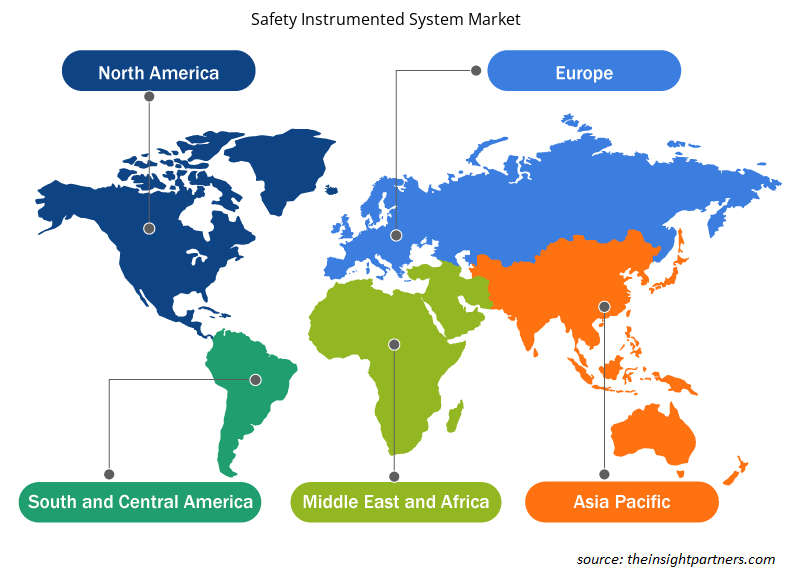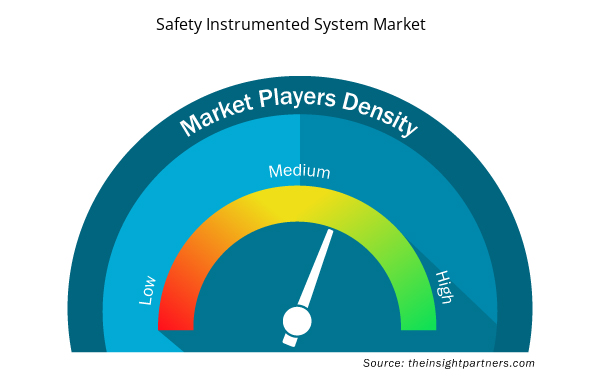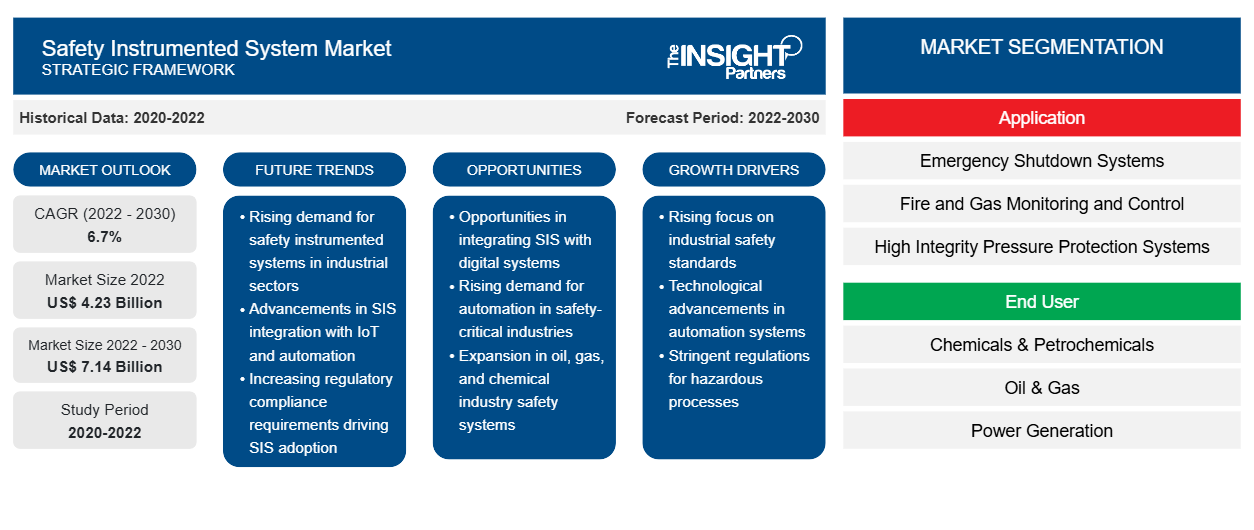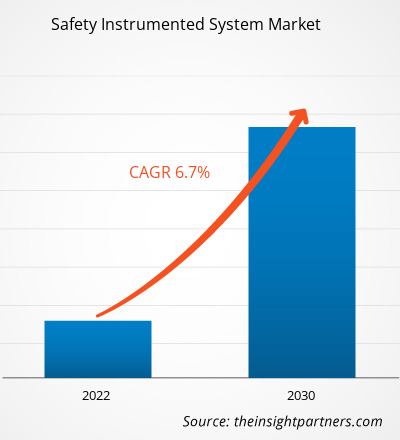[研究报告] 安全仪表系统市场预计将从 2022 年的 42.3 亿美元增长到 2030 年的 71.4 亿美元;预计 2022 年至 2030 年的复合年增长率为 6.7%。
分析师观点:
全球范围内新石油和天然气炼油厂的建设和采矿活动的增多是推动安全仪表系统市场增长的主要因素。此外,安全法规和标准的日益普及也推动了安全仪表系统市场的增长。此外,化工和石化行业日益增长的工业自动化提高了员工的效率和安全性,这进一步为安全仪表系统市场的增长创造了机会。不同行业对安全的意识不断增强,进一步加速了安全仪表系统市场的扩张。
市场概况:
许多过程工厂都使用安全仪表系统 (SIS),因为它有助于在异常情况发生时采取自动措施,使工厂保持安全状态。如果发生任何可能导致不幸事件的干扰,SIS 将自动将过程置于安全状态,并有助于防止人员伤亡、资产损失和环境破坏。在石油和天然气、化工和其他涉及重型机械和化学品的行业的不同作业现场,可能会发生多起灾难性事件。这些事件的范围从火灾到可能导致爆炸的泄漏,全球对 SIS 等高端安全系统的需求正在上升。
定制此报告以满足您的需求
您可以免费定制任何报告,包括本报告的部分内容、国家级分析、Excel 数据包,以及为初创企业和大学提供优惠和折扣
- 获取此报告的关键市场趋势。这个免费样品将包括数据分析,从市场趋势到估计和预测。
市场驱动因素:
石油和天然气行业的不断扩张推动安全仪表系统市场的增长
美国是世界上最大的天然气生产国之一。根据美国能源信息署 (EIA) 的数据,2021 年,该国生产了约 34,517,798 百万立方英尺 (MMcf) 的天然气,消耗了 30,664,951 MMcf 的天然气。该国还出口了 3,560,818 MMcf 的液化天然气 (LNG)。世界各地也在进行各种新的石油和天然气建设项目。2022 年第二季度,碳捕获和去除卓越中心项目的建设工作在加拿大不列颠哥伦比亚省本拿比开始。它涉及 CCS 工厂的建设,该工厂有助于每天捕获和储存多达 2,000 公吨的二氧化碳。同样,Vista Pacifico 液化天然气厂项目的建设于 2022 年第二季度开始,投资额为 20 亿美元。根据该项目,将在墨西哥锡那罗亚州托波洛班波市阿霍姆市 150 公顷土地上建造一个液化天然气出口终端。因此,此类石油和天然气建设项目将推动对安全仪表系统的需求。
此外,根据《2021 年瑞典采矿业统计报告》,瑞典矿石产量在 2021 年达到 8860 万公吨,比 2015 年增长了 22%。此外,根据澳大利亚统计局的数据,2023 年第一季度澳大利亚采矿产量增长了 5.7%。因此,全球采矿产量的增长预计将激增对安全和监控的需求,以确保员工、设备或材料的安全。对安全仪表系统日益增长的需求进一步推动了安全仪表系统市场的增长。
报告细分和范围:
安全仪表系统市场根据应用、最终用户和地理位置进行细分。根据应用,安全仪表系统市场分为紧急停机系统、火灾和气体监测和控制、高完整性压力保护系统、燃烧器管理系统和涡轮机械控制。根据最终用户,安全仪表系统市场分为化学品和石化产品、石油和天然气、发电、制药、食品和饮料等。从地理位置上看,安全仪表系统市场分为北美、欧洲、亚太地区 (APAC)、中东和非洲 (MEA) 和南美 (SAM)。
节段分析:
根据应用,安全仪表系统市场分为紧急停机系统、火灾和气体监测和控制、高完整性压力保护系统、燃烧器管理系统和涡轮机械控制。紧急停机系统部分在 2022 年占据了最大的安全仪表系统市场份额,预计在 2022-2030 年期间将实现最高复合年增长率。紧急停机 (ESD) 系统是高度可靠的控制系统,适用于具有爆炸风险的石油和天然气以及核电等高风险行业。该系统有助于在过程超出控制范围的情况下保护人员、工厂和环境。
区域分析:
2022 年,亚太地区占据了最大的安全仪表系统市场份额。该地区的化学和制药行业正在经历巨大的增长。该地区的市场参与者正在不断努力扩大其制造设施。例如,2022 年 12 月,Balaxi Pharmaceuticals 宣布他们已在印度 Telangana 启动新药制造工厂的建设。该公司在该项目上投资了约 1029 万美元(8.5 亿印度卢比)。新的生产设施将帮助该公司进入欧洲市场并提高当前市场的利润率。同样,2021 年 9 月,韩华公司宣布计划在 2024 年前建造一座硝酸生产厂。该工厂将在韩国丽水工业园区提供 400,000 公吨的年产能。为此,该公司将投资 1.62 亿美元(1900 亿韩元)。
因此,该地区新生产设施数量的增加将增加对安全仪表系统的需求,因为它有助于防止工厂发生任何事故,从而推动安全仪表系统市场的增长。
关键球员分析:
ABB Ltd、Applied Control Engineering Inc、AVEVA Group plc、Emerson Electric Co、HIMA、Honeywell International、Rockwell Automation Inc、施耐德电气、西门子股份公司和横河电机株式会社是该报告中介绍的主要安全仪表系统市场参与者。
安全仪表系统市场区域洞察
Insight Partners 的分析师已详细解释了预测期内影响安全仪表系统市场的区域趋势和因素。本节还讨论了北美、欧洲、亚太地区、中东和非洲以及南美和中美洲的安全仪表系统市场细分和地理位置。

- 获取安全仪表系统市场的区域特定数据
安全仪表系统市场报告范围
| 报告属性 | 细节 |
|---|---|
| 2022 年市场规模 | 42.3亿美元 |
| 2030 年市场规模 | 71.4亿美元 |
| 全球复合年增长率(2022 - 2030 年) | 6.7% |
| 史料 | 2020-2022 |
| 预测期 | 2022-2030 |
| 涵盖的领域 | 按应用
|
| 覆盖地区和国家 | 北美
|
| 市场领导者和主要公司简介 |
|
市场参与者密度:了解其对商业动态的影响
安全仪表系统市场正在快速增长,这得益于最终用户需求的不断增长,而这些需求又源于消费者偏好的不断变化、技术进步以及对产品优势的认识不断提高等因素。随着需求的增加,企业正在扩大其产品范围,进行创新以满足消费者的需求,并利用新兴趋势,从而进一步推动市场增长。
市场参与者密度是指在特定市场或行业内运营的企业或公司的分布情况。它表明在给定市场空间中,相对于其规模或总市场价值,有多少竞争对手(市场参与者)存在。
在安全仪表系统市场运营的主要公司有:
- ABB有限公司
- 应用控制工程公司
- AVEVA 集团
- 艾默生电气公司
- HIMA、霍尼韦尔国际
免责声明:上面列出的公司没有按照任何特定顺序排列。

- 获取安全仪表系统市场顶级关键参与者概览
最新动态:
安全仪表系统市场参与者高度采用无机和有机策略。以下列出了一些近期的关键市场发展:
- 2022 年 5 月,艾默生推出了配备 HART 7 的 TopWorxTM DX PST。该设备提供有价值的阀门数据和诊断信息,从而实现过程应用的数字化转型。新型 DX PST 与现有阀门和控制系统无缝集成,使操作员可以访问关键阀门数据、趋势和诊断信息,这些数据、趋势和诊断信息可用于预测和安排维护。DX PST 具有安全完整性等级 3 (SIL 3),与 ASCOTM 系列高级冗余控制系统 (ARCS) 搭配使用时,可提供集成的 2oo2 或 2oo3 电磁阀冗余,以进一步增强安全性和开放端子,允许使用额外的压力变送器和两个压力开关。
- 2022 年 3 月,INTECH 获得一份合同,为中东一个主要油田的现场集油基础设施提供高完整性压力保护系统 (HIPPS)。根据这份合同,中东油田公司寻求 INTECH 的专业知识,在歧管下游制造和安装 IOPPS 套件,以保护干线和脱气站免受潜在的过压。
- 2020 年 11 月,ABB 推出了用于提升机的 ABB Ability Safety Plus,这是一套矿井提升机安全产品,为采矿业带来了最高水平的人员和设备安全。这些产品包括安全增强提升机监控器 (SPHM)、安全增强提升机保护器 (SPHP) 和安全增强制动系统 (SPBS),包括安全制动液压系统 (SBH)。
- 历史分析(2 年)、基准年、预测(7 年)及复合年增长率
- PEST 和 SWOT 分析
- 市场规模价值/数量 - 全球、区域、国家
- 行业和竞争格局
- Excel 数据集



Report Coverage
Revenue forecast, Company Analysis, Industry landscape, Growth factors, and Trends

Segment Covered
This text is related
to segments covered.

Regional Scope
North America, Europe, Asia Pacific, Middle East & Africa, South & Central America

Country Scope
This text is related
to country scope.
常见问题
The US held the largest safety instrumented system market share in 2022.
The incremental growth expected to be recorded for the safety instrumented system market during the forecast period is US$ 2.90 billion.
Rising expansion in oil & gas industry and growing adoption of safety regulations and standards are the major factors that propel the safety instrumented system market.
The key players holding majority shares in the safety instrumented system market are Rockwell Automation Inc, Honeywell International, Emerson Electric Co, Yokogawa Electric Corporation, and ABB Ltd.
Asia Pacific is anticipated to grow with the highest CAGR over the forecast period.
The Safety instrumented system market is expected to reach US$ 7.14 billion by 2030.
Growing awareness of safety across different industries is anticipated to play a significant role in the safety instrumented system market in the coming years.
The safety instrumented system market was estimated to be US$ 4.23 billion in 2022 and is expected to grow at a CAGR of 6.7 % during the forecast period 2023 - 2030.
Trends and growth analysis reports related to Electronics and Semiconductor : READ MORE..
The List of Companies - Safety Instrumented System Market
- ABB Ltd
- Applied Control Engineering Inc
- AVEVA Group plc
- Emerson Electric Co
- HIMA, Honeywell International
- Rockwell Automation Inc
- Schneider Electric
- Siemens AG
- Yokogawa Electric Corporation
The Insight Partners performs research in 4 major stages: Data Collection & Secondary Research, Primary Research, Data Analysis and Data Triangulation & Final Review.
- Data Collection and Secondary Research:
As a market research and consulting firm operating from a decade, we have published and advised several client across the globe. First step for any study will start with an assessment of currently available data and insights from existing reports. Further, historical and current market information is collected from Investor Presentations, Annual Reports, SEC Filings, etc., and other information related to company’s performance and market positioning are gathered from Paid Databases (Factiva, Hoovers, and Reuters) and various other publications available in public domain.
Several associations trade associates, technical forums, institutes, societies and organization are accessed to gain technical as well as market related insights through their publications such as research papers, blogs and press releases related to the studies are referred to get cues about the market. Further, white papers, journals, magazines, and other news articles published in last 3 years are scrutinized and analyzed to understand the current market trends.
- Primary Research:
The primarily interview analysis comprise of data obtained from industry participants interview and answers to survey questions gathered by in-house primary team.
For primary research, interviews are conducted with industry experts/CEOs/Marketing Managers/VPs/Subject Matter Experts from both demand and supply side to get a 360-degree view of the market. The primary team conducts several interviews based on the complexity of the markets to understand the various market trends and dynamics which makes research more credible and precise.
A typical research interview fulfils the following functions:
- Provides first-hand information on the market size, market trends, growth trends, competitive landscape, and outlook
- Validates and strengthens in-house secondary research findings
- Develops the analysis team’s expertise and market understanding
Primary research involves email interactions and telephone interviews for each market, category, segment, and sub-segment across geographies. The participants who typically take part in such a process include, but are not limited to:
- Industry participants: VPs, business development managers, market intelligence managers and national sales managers
- Outside experts: Valuation experts, research analysts and key opinion leaders specializing in the electronics and semiconductor industry.
Below is the breakup of our primary respondents by company, designation, and region:

Once we receive the confirmation from primary research sources or primary respondents, we finalize the base year market estimation and forecast the data as per the macroeconomic and microeconomic factors assessed during data collection.
- Data Analysis:
Once data is validated through both secondary as well as primary respondents, we finalize the market estimations by hypothesis formulation and factor analysis at regional and country level.
- Macro-Economic Factor Analysis:
We analyse macroeconomic indicators such the gross domestic product (GDP), increase in the demand for goods and services across industries, technological advancement, regional economic growth, governmental policies, the influence of COVID-19, PEST analysis, and other aspects. This analysis aids in setting benchmarks for various nations/regions and approximating market splits. Additionally, the general trend of the aforementioned components aid in determining the market's development possibilities.
- Country Level Data:
Various factors that are especially aligned to the country are taken into account to determine the market size for a certain area and country, including the presence of vendors, such as headquarters and offices, the country's GDP, demand patterns, and industry growth. To comprehend the market dynamics for the nation, a number of growth variables, inhibitors, application areas, and current market trends are researched. The aforementioned elements aid in determining the country's overall market's growth potential.
- Company Profile:
The “Table of Contents” is formulated by listing and analyzing more than 25 - 30 companies operating in the market ecosystem across geographies. However, we profile only 10 companies as a standard practice in our syndicate reports. These 10 companies comprise leading, emerging, and regional players. Nonetheless, our analysis is not restricted to the 10 listed companies, we also analyze other companies present in the market to develop a holistic view and understand the prevailing trends. The “Company Profiles” section in the report covers key facts, business description, products & services, financial information, SWOT analysis, and key developments. The financial information presented is extracted from the annual reports and official documents of the publicly listed companies. Upon collecting the information for the sections of respective companies, we verify them via various primary sources and then compile the data in respective company profiles. The company level information helps us in deriving the base number as well as in forecasting the market size.
- Developing Base Number:
Aggregation of sales statistics (2020-2022) and macro-economic factor, and other secondary and primary research insights are utilized to arrive at base number and related market shares for 2022. The data gaps are identified in this step and relevant market data is analyzed, collected from paid primary interviews or databases. On finalizing the base year market size, forecasts are developed on the basis of macro-economic, industry and market growth factors and company level analysis.
- Data Triangulation and Final Review:
The market findings and base year market size calculations are validated from supply as well as demand side. Demand side validations are based on macro-economic factor analysis and benchmarks for respective regions and countries. In case of supply side validations, revenues of major companies are estimated (in case not available) based on industry benchmark, approximate number of employees, product portfolio, and primary interviews revenues are gathered. Further revenue from target product/service segment is assessed to avoid overshooting of market statistics. In case of heavy deviations between supply and demand side values, all thes steps are repeated to achieve synchronization.
We follow an iterative model, wherein we share our research findings with Subject Matter Experts (SME’s) and Key Opinion Leaders (KOLs) until consensus view of the market is not formulated – this model negates any drastic deviation in the opinions of experts. Only validated and universally acceptable research findings are quoted in our reports.
We have important check points that we use to validate our research findings – which we call – data triangulation, where we validate the information, we generate from secondary sources with primary interviews and then we re-validate with our internal data bases and Subject matter experts. This comprehensive model enables us to deliver high quality, reliable data in shortest possible time.


 获取此报告的免费样本
获取此报告的免费样本